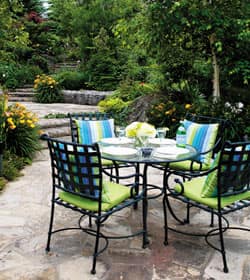Gardens
How to: Create the garden of your dreams

How to: Create the garden of your dreams
Gardens
How to: Create the garden of your dreams
“The first thing I do in the morning is take my cappuccino and stroll into the garden to look at the beautiful plants,” says the homeowner of this lush retreat north of Toronto. Designed by Randy Tumber of Tumber & Associates in Orangeville, Ont., the garden has won provincial, national and international awards for technical achievement and water features, among others. But talking to Tumber, you sense the accolades are secondary. He speaks of exploring the hearts and minds of his clients in the info-gathering stage and of how evoking an emotional response is more important than a flashy presentation.
Here are his thoughts on what makes this a special garden and how to translate these principles into your own piece of paradise.
 1 Goals
1 Goals
Gathering info is the first step in the design process. What do you want from your garden? How will you use it? For quiet meditation? Entertaining? Do you have a green thumb? “It's crucial to know the goals and aspirations of my clients,” says landscape artist Randy Tumber. These homeowners love the simple things. They entertain close friends here, but in small groups.
2 Integration
Designing a garden that suited its environment and the Frank Lloyd Wright-style architecture of the house was paramount to Tumber and the homeowners. Native plants like pagoda dogwood (Cornus alternifolia) were a natural choice and are also low maintenance.
 3 Repetition
3 Repetition
Tumber likes repetition because “you see it in nature.” Birch trees and ‘Stella d'Oro' day lilies are like punctuation marks that lead the eye down stone steps and across the lower terrace. Both plants are especially effective because they stand out: the white birchbark contrasts with the abundance of green, and the orange lilies are a look-at-me colour and blossom from spring to the first snow.
4 Mystery
“By controlling the line of vision along this path, we created a sense of mystery, which I like in a garden,” says Tumber. “Where does the stone stairway lead? It makes you want to go farther.” The shape of the path and how it disappears into the lush greenery pique curiosity and engage the visitor's imagination.
 5 Sound
5 Sound
To build a waterfall, Tumber brought in massive boulders to create a series of large cascades that look as though they were carved out by nature. The rushing sound of water adds a sensory experience – a key element of his designs. Elsewhere, bordering the path that descends into the lower garden, is a white pine. “The wind moving through the soft needles makes a whispering sound,” he says.
6 Scent
The hybrid ‘David Austin' rose, which has a classic fragrance, is a favourite of the homeowner's. Scent is another way to trigger sensory experiences. For example, “Star Gazer“ lilies by a front entrance give people a pleasant aromatic experience upon arriving,” says Tumber.
 7 Focal point
7 Focal point
Tumber tries to avoid making one element an overwhelming focal point; instead, he likes to integrate the various features into the landscape. “When nothing is dominant, it's pleasant – more natural looking,” he says. A large spruce and oakleaf hydrangea (climbing up the pillar) provide a natural flow, pulling the eye toward the taller canopy of trees in the distance.
8 Moods
Different parts of a garden should offer different moods. To evoke a meditative quality, Tumber included quiet ponds on either side of the gazebo. An underwater pump silently circulates water without creating ripples; elsewhere water rushes down a series of cascades, but here the mood is calming.
 9 Mass plantings
9 Mass plantings
“We use lots of mass plantings,” says Tumber, for visual impact and for practical reasons too. “Six to seven junipers will grow into one large area; weeds will have no room to germinate as the junipers grow and block the sun from reaching the soil underneath.” In this award-winning garden, the pink blooms of a ‘Gold Flame' spirea add hits of colour.
10 Separation
Pathways and bridges meander through this multi-level site, creating numerous private, secluded areas. To further the sense of enclosure, Tumber positioned terraces away from the house. “I like to create a green buffer between a house and terraces,” he says. Otherwise the harsh vertical lines of a structure meeting the horizontal ground feels overwhelming, as though the architecture looms over you. Trees and shrubs create a “safety blanket” for the garden, says Tumber, making the space “an emotional retreat.”
There are key things landscape artist Randy Tumber considers when designing a garden. Follow these guidelines – in this order – to obtain your own well-planned space.
1 Practicality
“The design has to function for pedestrians as well as for vehicles,” says Tumber. (This point pertains to driveways, for instance.) In this garden, the steps and pathway are wide for easy traffic flow.
2 Maintenance
Tumber advises clients to include more shrubs and fewer perennials, which require substantial moving, dividing and pruning over time (that's why he loves native plants). Here, the trees and shrubs are low maintenance.
3 Aesthetic
“People think of aesthetics before anything else, but practicality and maintenance should come first when designing a garden.”














Comments